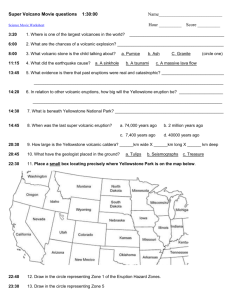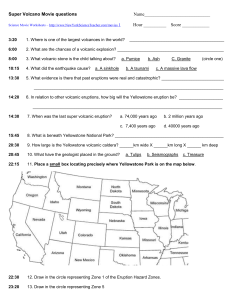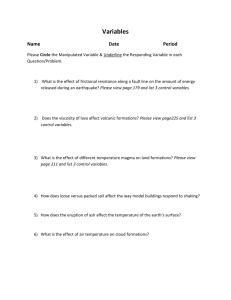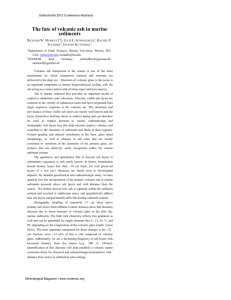volcano a vent in the earth`s crust through which lava, steam, ashes
advertisement
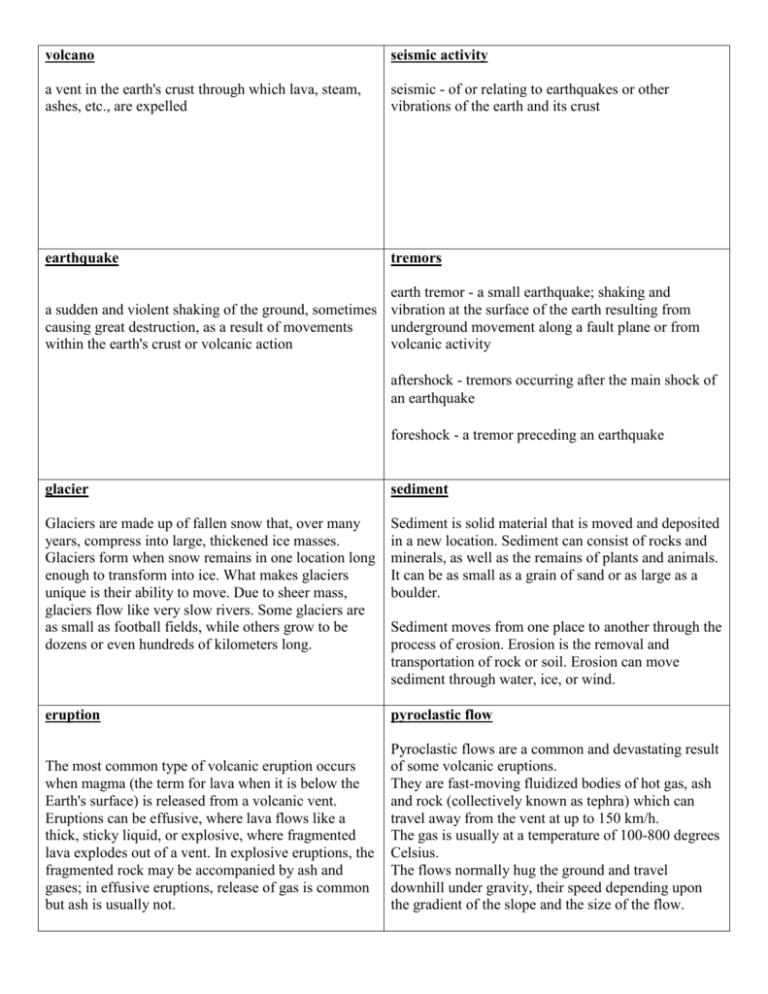
volcano seismic activity a vent in the earth's crust through which lava, steam, ashes, etc., are expelled seismic - of or relating to earthquakes or other vibrations of the earth and its crust earthquake tremors earth tremor - a small earthquake; shaking and a sudden and violent shaking of the ground, sometimes vibration at the surface of the earth resulting from causing great destruction, as a result of movements underground movement along a fault plane or from within the earth's crust or volcanic action volcanic activity aftershock - tremors occurring after the main shock of an earthquake foreshock - a tremor preceding an earthquake glacier sediment Glaciers are made up of fallen snow that, over many years, compress into large, thickened ice masses. Glaciers form when snow remains in one location long enough to transform into ice. What makes glaciers unique is their ability to move. Due to sheer mass, glaciers flow like very slow rivers. Some glaciers are as small as football fields, while others grow to be dozens or even hundreds of kilometers long. Sediment is solid material that is moved and deposited in a new location. Sediment can consist of rocks and minerals, as well as the remains of plants and animals. It can be as small as a grain of sand or as large as a boulder. eruption pyroclastic flow The most common type of volcanic eruption occurs when magma (the term for lava when it is below the Earth's surface) is released from a volcanic vent. Eruptions can be effusive, where lava flows like a thick, sticky liquid, or explosive, where fragmented lava explodes out of a vent. In explosive eruptions, the fragmented rock may be accompanied by ash and gases; in effusive eruptions, release of gas is common but ash is usually not. Pyroclastic flows are a common and devastating result of some volcanic eruptions. They are fast-moving fluidized bodies of hot gas, ash and rock (collectively known as tephra) which can travel away from the vent at up to 150 km/h. The gas is usually at a temperature of 100-800 degrees Celsius. The flows normally hug the ground and travel downhill under gravity, their speed depending upon the gradient of the slope and the size of the flow. Sediment moves from one place to another through the process of erosion. Erosion is the removal and transportation of rock or soil. Erosion can move sediment through water, ice, or wind. flash flood ash fallout Flash floods are short-term events, occurring within 6 hours of the causative event (heavy rain, dam break, levee failure, rapid, snowmelt and ice jams) and often within 2 hours of the start of high intensity rainfall. A flash flood is characterized by a rapid stream rise with depths of water that can reach well above the banks of the creek. Flash flood damage and most fatalities tend to occur in areas immediately adjacent to a stream. Additionally, heavy rain falling on steep terrain can weaken soil and cause mud slides, damaging homes, roads and property. Flash floods can be produced when slow moving or multiple thunderstorms occur over the same area. When storms move faster, flash flooding is less likely since the rain is distributed over a broader area. Volcanic ash consists of tiny jagged pieces of rock and glass. Ash is hard, abrasive, mildly corrosive, conducts electricity when wet, and does not dissolve in water. Ash is spread over broad areas by wind. electrostatic field magnetism in ash An electric field or electrostatic field describes the charged area near any electrically-charged object. Some ash can contain the iron oxide mineral magnetite. If you plan to travel to a beach on a tropical volcanic island, take along a strong little magnet and look for magnetite. hypothermia Ring of Fire Hypothermia is a medical emergency that occurs when your body loses heat faster than it can produce heat, causing a dangerously low body temperature. Normal body temperature is around 98.6 F (37 C). Hypothermia (hi-poe-THUR-me-uh) occurs as your body temperature passes below 95 F (35 C). The Ring of Fire is an area where a large number of earthquakes and volcanic eruptions occur in the basin of the Pacific Ocean. In a 40,000 km (25,000 mi) horseshoe shape, it is associated with a nearly continuous se ries of oceanic trenches, volcanic arcs, and volcanic belts and/or plate movements. It has 452 volcanoes and is home to over 75% of the world's active and dormant volcanoes. When your body temperature drops, your heart, nervous system and other organs can't work normally. Left untreated, hypothermia can eventually lead to complete failure of your heart and respiratory system and to death. Hypothermia is most often caused by exposure to cold weather or immersion in a cold body of water. Primary treatments for hypothermia are methods to warm the body back to a normal temperature. Falling ash can turn daylight into complete darkness. Accompanied by rain and lightning, the gritty ash can lead to power outages, prevent communications, and disorient people. succession in environment Succession is the observed changes in an ecological community over time. These changes are fairly predictable and orderly. Within an ecological community, the species composition will change over time as some species become more prominent while others may fade out of existence. As the community develops over time, vegetation grows taller, and the community becomes more established. Primary succession is initiated when a new area that has never previously supported an ecological community is colonized by plants and animals. This could be on newly exposed rock surfaces from landslides or lava flows. Secondary succession occurs when an area that has previously had an ecological community is so disturbed or changed that the original community was destroyed and a new community moves in. This is more common than primary succession, and is often the result of natural disasters such as fires, floods, and winds, as well as human interference such as logging and clear-cutting. Seasonal succession is another type of succession, but instead of being the result of a disastrous event, it is caused by cyclical changes in the environment or interactions between the species in a community.

